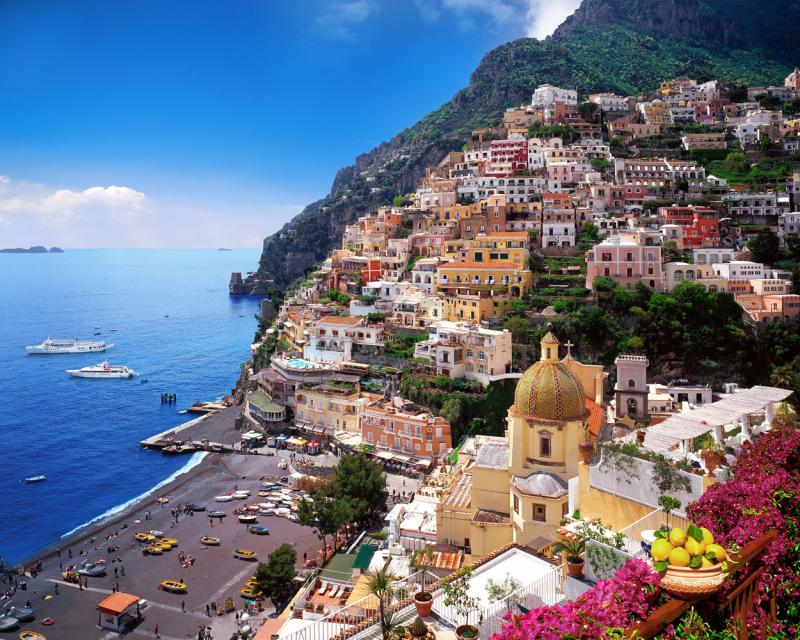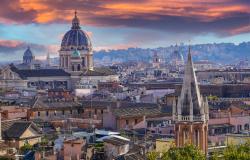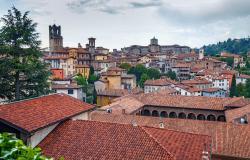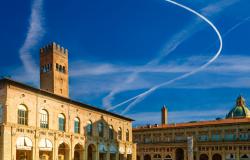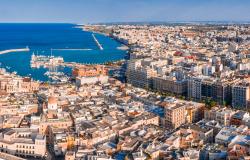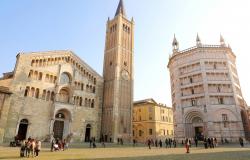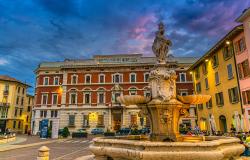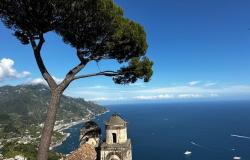Like a jewel in the beautiful setting of Italy’s famous Amalfi coast, Positano looks peacefully down on an enchanting stretch of the Mediterranean which for generations has been the goal of artists and literary figures.
In summer, Positano awakens as the rays of the year’s first really hot sun raise this Sleeping Beauty from a deep sleep. The small number of tourists who venture here in winter grows quickly with the arrival of the summer season, swelling the indigenous population of around 4000. The Babel of dialects and languages is heard once more, confirming the cosmopolitan nature of the place.
The sea sparkles brilliantly and the citrus trees explode in a riot of colours and scents. Strolling along the many little shops which line the narrow, tortuous streets, visitors eye the sarongs and bikinis, the famous sandals made while you wait and the pottery. All ‘Made in Positano’ – who would think otherwise? The town’s proud and skilled craftsmen often have their workrooms in the back of the shop so that customers, if they wish, can see the items being made.
Visitors welcome and unwelcome

This land, beloved of Poseidon (the Greek god of the sea who, according to legend, wished to drown one of its citizens to mark his love for the sea-nymph Pasitea) has always bewitched those who came across it. The Romans built an important patrician villa here, close to the extensive beach.
This confirmed the importance and strategic value of the site. However, with the fall of the Empire the people of Positano had to fight tooth and nail to preserve their freedom. For this reason they built three guard towers, at Fornillo, Trasita and Sponda, to ward off the incursions of the Saracens and Turks. Only when they became part of the great Amalfi maritime Republic could they devote themselves to the peaceful activity to which they were best suited – trade and exchange with the East.
A magnet for artists

For centuries this fascinating pearl of the coast remained unchanged. The artist Paul Klee (1879- 1940) described Positano as ‘the only place in the world conceived on a vertical rather than a horizontal axis’, warm praise for the architectural skill and inventiveness of a people who were not intimidated by the steep contours of the area and decided to settle there anyway.
It was perhaps as a response to the emotions aroused by these words that the end of the Second World War saw the start of a steady pilgrimage by throngs of artists and literary figures from Germany, Russia and other countries (these inclu-ded John Steinbeck and the Italians Corrado Alvaro, Dino Buzzati and Alberto Moravia). The tradition of foreign visitors continues to the present day. ‘I missed ‘O sole mio’.
Try something different
Ah yes, the food, another attraction of this exceptional area. ‘If someone wants to eat a perfect fish soup, of course he has to come here,’ explains Salvatore Russo, owner of the famous Chez Black restaurant. ‘We can also delight the palate with many other local specialities: seafood spaghetti, for example, or Paccheri di Gragnano (a special type of pasta) cooked with a squid and octopus sauce. This is a very sophisticated recipe in the true Positano tradition’.
After a good meal, you may feel the need to walk it off, perhaps by seeking out one of Positano’s many beautiful churches. You should definitely include a tour of the Chiesa Santa Maria dell’Assunta. This building, with its splendid dome with majolica mosaics, can be found in the little Piazza Flavio Gioia and contains works of art such as the Circumcision by Fabrizio Santafede (late 16th century) and an 18th – century panel of the Madonna and Child in the Byzantine style. The bell tower, a typical feature, has a bas-relief of a Pistrice, a mythological creature, half fish half dragon.
Taking Positano home

Taking away a bit of this wonderful architectural heritage is not as difficult or destructive as it might seem. Just go to one of the local ceramicists, who often decorate their work with images of the town’s most important monuments.
However, if your taste is for more traditional art, make your way to the Parlato workshop, in the historic Liparlati area. Here craftsmen create traditional hand-made objects based on subjects dear to the hearts of Germans in the 1920s (the daily life of fishermen, for example). As Signora Berenice explains, ‘Our workshop is perhaps the only one in Positano where the craftsmen produce the ceramics themselves.
Many get theirs from Vietri, but not us. We prefer only to work to order, so the client can personalise the piece as he wishes and be sure that he has something unique’. Which articles are most popular with tourists? ‘Probably sets of plates, although there is a lot of call for jugs for sangria and traditional pots for soaking bread to make panzanella or caponata.’ This is proof of the fact that for the inhabitants of Positano, practical sea-faring people, art is only appreciated if it can be used in everyday life.
Further Information
Check out our Foodie Fun in Campania and read about Insalata Caprese or find out How to Make Limoncello. More news about Campania Map of Campania Accommodation in Campania
